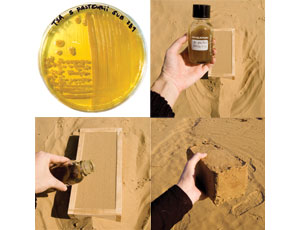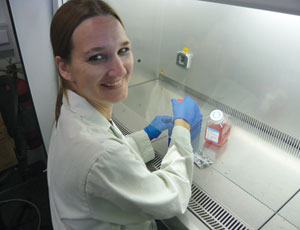An American architecture professor at a university in the Middle East is developing an energy-saving way to make bricks using bacteria known for its ability to solidify sand.



Ginger Krieg Dosier, assistant professor of architecture at the American University of Sharjah in the United Arab Emirates, has developed a method that involves filling a form with alternating layers of sand and a solution containing urea, calcium chloride and the non-pathogenic Sporosarcina pasteurii (or Bacillus pasteurii). Within a few days, a chain of chemical reactions yields a mineral growth that seeps between the grains of sand and “biocements” them together into a brick.
The process eliminates the need to burn coal or other fuel to heat a kiln to 2,000° F, as is commonly required in clay-brick production. Not burning fuel cuts down immensely on the amount of carbon released into the atmosphere during brick production. Dosier estimates that if her method were to replace the current way of making the 1.2 trillion bricks produced worldwide each year, it would reduce carbon emissions by 800 million tons annually.
Dosier, who taught herself chemistry with the help of mentors, now is working on controlling her bricks’ specific properties. Varying the process, she says, can produce bricks as soft as sandstone or as hard as marble.
“This summer I will conduct many tests on the bricks’ hardness, brittleness, water-resistance, freeze-thaw reactions and long-term weather resistance,” she says. “The goal is to provide structural and performance properties similar to standard clay brick.” Dosier is encouraged by early experiments: She stored small-scale bricks in containers of water for more than three months without detecting any change.
Although her brick-building process burns no fuel, it does give off ammonia, a small amount of carbon dioxide and some effluent. Dosier captures these emissions in a closed-loop system, which will be used when she eventually tries full-scale manufacturing tests. Dosier says she has received requests for the waste from people who want to use it for fertilizer or in industrial processes.
The ecologically conscious Dosier is now working with environmental engineers to ensure the process is not creating any contamination or gas that she has not monitored. She plans to conduct extensive testing this summer.
Dosier notes that her process is still experimental, but, ultimately, she wants to mass-produce the bio-made bricks. So far, creating an 8-in. x 33/4-in. x 21/2-in. bacteria-and-sand brick takes about five days, compared to two days plus cooling time for a typical kiln-baked clay brick. But Dosier expects to accelerate the production time.
Further, she plans to make them cost-competitive with baked-clay bricks. “One of the foremost goals of the research is to make the cost as low as possible,” she says. “Right now, each [experimental] brick costs $2.70. My goal is to get down to less than 50¢ per brick, the same as standard clay brick.”
Although Dosier initially plans to target use in lesser-developed countries, where people don’t have access to typical construction materials, she is equally interested in having them used like clay bricks in more-developed countries. “I have plans this year of working in the UAE with local Bedouin and also have been in contact with several heritage centers here that have shown interest in renovation projects,” she says. “I am currently looking for future collaborations on testing and use in the U.S., too.”
Dosier believes that bio-made bricks could eventually supplant more than just standard clay bricks. “I can see this method being used to replace [concrete] block, retaining walls, tilt-up construction, paving and walkway infrastructure, pre-cast units and water-related applications,” she says. “Right now, the sky is the limit in terms of possibilities.”

Post a comment to this article
Report Abusive Comment